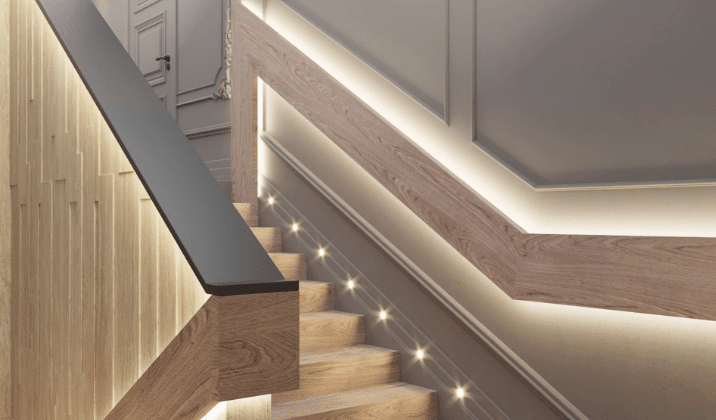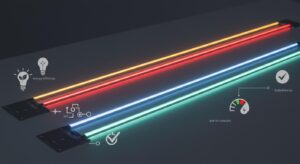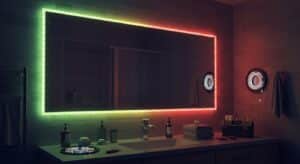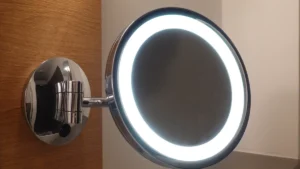
Interior design LED strip lighting has transformed the way we illuminate our homes. They not only look cool but also save energy and can be utilized in various applications. Did you know that interior design LED strip lighting is incredibly popular?
The market for these lights reached $4.4 billion in 2023 and is projected to grow to $12 billion by 2031.
They provide brightness comparable to regular bulbs, delivering 450 lumens per foot.
These lights are perfect for modern designs, seamlessly blending function with style.
Key Takeaways
Pick LED strips based on how bright you need them. For normal lighting, use strips with 450 lumens per foot. For decoration, 300 lumens per foot is enough.
Think about color temperature to set the mood. Warm colors (2700K-3000K) feel cozy, while cool colors (4000K-6000K) help you focus in work areas.
Choose energy-saving strips with good brightness efficiency. Get strips with at least 100 lumens per watt to save money and make them last longer.
Key Things to Know About Interior Design LED Strip Lighting
Brightness and Lumens
When picking LED strip lights, brightness is very important. Brightness is measured in lumens, which shows how much light the strip gives off. For example, a high-quality LED strip gives about 450 lumens per foot. This is as bright as a T8 fluorescent lamp. If you want accent lighting, strips with 300 lumens per foot work well. But for task lighting, you’ll need brighter strips.
LED Strip Light Type | Lumen Output (per foot) | Comparison |
|---|---|---|
Good Quality LED Strip | 450 lumens | Similar to T8 fluorescent lamp |
UltraBright Accent Series | 300 lumens | Medium brightness for accents |
Remember, higher lumens mean brighter light. Pick the right one for your needs.
Color Temperature and Mood
Color temperature helps set the feel of a room. It’s measured in Kelvin (K) and ranges from warm (2700K-3000K) to cool (4000K-6000K). Warm tones are cozy and great for bedrooms or living rooms. Cool tones are better for workspaces where focus is needed. Some LED strips let you change the color temperature, so you can adjust it as needed.
Tip: Use warm tones for relaxing spaces and cool tones for work areas.
LED Density and Light Quality
The number of LEDs per foot affects brightness and smoothness. A strip with 36 LEDs per foot gives about 450 lumens. One with 120 LEDs per foot can give up to 1500 lumens. Higher density strips also reduce dark spots, making the light more even.
LED Density (per foot) | Brightness (lumens per foot) | Power Use (watts per foot) |
|---|---|---|
36 LEDs | 450 | 4 |
120 LEDs | 1500 | 15 |
Energy Use and Efficiency
Energy efficiency is also important. Look for strips with high luminous efficacy, which shows how much light is made per watt. A good number is 100 lumens per watt. Efficient strips save energy and cost less over time. COB LED strips are more efficient than SMD LED strips, which use more power and make more heat.
Fun Features (RGB, RGBW, Smart Controls)
For stylish lighting, RGB and RGBW LED strips are great. RGB strips mix red, green, and blue to make many colors. RGBW strips add white light for more options. Many strips have smart controls to change brightness, colors, or sync with music. Some work with Alexa or Google Home for voice control.
Feature | Description |
|---|---|
RGB Color Changing | Offers 20 preset colors and 6 DIY options. |
Smart Integration | Works with Alexa, Google Home, and Apple HomeKit. |
Music Synchronization | Lights match the beat of the music. |
RGB LED strips are great for fun effects, like parties or movie nights.
Comparing Popular Interior LED Strip Lighting Options

Standard White LED Strips
Standard white LED strips are a simple and reliable option. They give bright, steady light, perfect for general lighting needs. These strips often produce 450 lumens per foot, which is as bright as fluorescent lamps.
Choose strips with at least 100 lumens per watt for energy savings. A CRI of 80 or more is important for showing colors accurately. This makes them great for kitchens, offices, or spaces where true colors are needed.
Tip: Use dimmers with white LED strips to adjust the mood easily.
RGB and RGBW LED Strips
RGB and RGBW LED strips are great for adding fun colors. RGB strips mix red, green, and blue lights to make many colors. RGBW strips add white light for even more options. These are perfect for parties, accents, or lively spaces.
Type of LED Strip | Power Use | Color Quality | Best Use |
|---|---|---|---|
RGB LED Strips | Uses more power | Moderate CRI | Billboards, stadiums |
RGBW LED Strips | More efficient | Better CRI | Homes, mood lighting |
RGB strips can change colors or sync with music using smart controls. They’re fun and stylish for modern homes.
Smart LED Strips for Modern Interiors
Smart LED strips are advanced and easy to use. They work with systems like Alexa or Google Home. You can control them with your voice or an app to change brightness, colors, or sync with music.
These strips usually provide 450 lumens per foot, similar to fluorescent lights. They are made with materials that reduce heat, making them last longer. Features like timers and energy-saving modes make them ideal for tech lovers.
High-Density LED Strips for Bright Spaces
High-density LED strips are made for areas needing extra light. They have more LEDs per meter, often up to 120 LEDs. This gives over 1500 lumens per meter, perfect for stores or bright spaces.
Feature | High-Density Strips | Standard Strips |
|---|---|---|
LEDs per meter | Higher (e.g., 120) | Lower (e.g., 60) |
Light Output (lumens per meter) | 1500+ | 900-1200 |
Light Smoothness | Very smooth | May have dark spots |
These strips also spread light evenly, removing dark areas and giving a smooth glow.
Waterproof LED Strips for Kitchens and Bathrooms
Waterproof LED strips are perfect for wet places like bathrooms or kitchens. They have an IP rating that shows how well they resist water and dust. For wet areas, pick strips with an IP65 rating or higher.
You can find waterproof strips in styles like white, RGB, or RGBW. They are tough and stylish, keeping your lighting safe and looking good in damp spaces.
Note: Always check the IP rating before using LED strips in wet areas to keep them safe and long-lasting.
Performance Analysis of Interior LED Strip Lighting
Brightness Levels for Different Applications
Brightness is important when picking LED strip lights. For general lighting, choose strips with at least 450 lumens per foot. High-density strips, offering up to 1500 lumens per meter, are great for bright areas like kitchens. Accent lighting works well with lower brightness, around 300 lumens per foot.
Here’s a simple guide to compare performance:
Metric | Description |
|---|---|
Lumens per foot | Good strips give at least 450 lumens per foot. |
Luminous efficacy | Shows how much light is made for the power used. |
Color rendering index (CRI) | Tells how true colors look under the light. Higher CRI is better. |
Correlated color temperature | Measures if the light feels warm or cool, in Kelvin (K). |
Power draw per foot | Quality strips use 4 watts per foot or more. |
LED density | More LEDs per foot give smoother light and fewer dark spots. |
Energy Efficiency and Lifespan
Energy-saving LED strips are a smart choice. Look for strips with high luminous efficacy, meaning they make more light using less power. Efficient strips last longer and save money on energy bills. COB LED strips are better than SMD strips because they use less power and last longer.
Color Rendering and Design Appeal
CRI shows how well colors look under the light. A CRI of 80 or more makes colors look real and bright. This is great for places like art rooms or stores. High CRI lights also make your room decor stand out.
CRI is scored from 0 to 100, with 100 being perfect.
High CRI lights are best for spaces needing true color accuracy.
Best Choices for Accent and Task Lighting
RGB and RGBW LED strips are fun for accent lighting. They add color and can sync with music for parties. For task lighting, pick brighter strips. High-density strips with 120 LEDs per meter give bright, even light for kitchens or workspaces.
Tip: Dimmable LED strips let you switch between accent and task lighting easily.
Practical Tips for Picking the Best LED Strip Lights
Choosing LED Strips for Different Rooms
Pick LED strips based on the room’s purpose. In kitchens, bright high-density strips are great for tasks. Bedrooms feel cozy with soft, warm-toned strips. Bathrooms need waterproof strips rated IP65 or higher to resist water.
Living rooms look stylish with accent lighting. Place strips under shelves, behind TVs, or along ceilings for a soft glow. For workspaces, cooler-toned strips help you concentrate better.
Tip: Dimmable strips let you change brightness for any activity or time.
Matching LED Strips to Your Design Style
Your lighting should fit your room’s style. For a modern vibe, try RGB or addressable LED strips. These let you pick colors and effects for a fun look. For a simple style, white strips with even light work best.
Think about where to place them. Hidden strips under cabinets or furniture give a soft, indirect glow. This makes the room feel nice without being too bright.
Finding the Right Balance of Cost and Quality
It’s important to balance price and quality. Good-quality strips cost more but last longer and use less energy. Look for strips with at least 100 lumens per watt for efficiency.
Cheaper strips might not last or be bright enough. Spending more on trusted brands means better lighting and fewer replacements.
Note: Check reviews and details before buying to avoid bad products.
LED strip lights come in many types for different needs. COB strips are brighter, give even light, and look sleek. SMD strips cost less but don’t last as long.
Feature | COB LED Strips | SMD LED Strips |
|---|---|---|
Brightness | Very bright, stays cool | Brightness depends on type (e.g., SMD 5050 is brighter than SMD 3528) |
Light Quality | Smooth light, no shadows | Light dots are visible, uneven glow |
Energy Efficiency | Uses less power, saves energy | Uses more power, gets hotter |
Design | Thin, bendable, modern look | Thicker, shows LED dots |
Durability | Tough, resists dust and damage | Easier to break, fragile diodes |
Longevity | Lasts longer over time | Wears out faster |
Cost | Costs more for better tech | Cheaper, good for tight budgets |
For colorful accents, RGB or RGBW strips are fun and lively. High-density strips are great for bright tasks like cooking or working. LED strips save energy and last longer than old-style lights, helping you save money.
Tip: Pick lights based on your room’s use and style. Spending more on quality strips can save money later.
FAQ
What’s the best LED strip light for a bedroom?
Warm-toned LED strips (2700K-3000K) create a cozy vibe. Dimmable options let you adjust brightness for relaxation or reading.
Tip: Install strips under the bed or along the ceiling for a soft glow.
Can LED strip lights be cut to fit smaller spaces?
Yes! Most LED strips have marked cut points. You can trim them to fit shelves, cabinets, or tight corners.
Note: Use scissors carefully and follow the manufacturer’s instructions.
How do I install LED strip lights?
Peel off the adhesive backing and stick the strip where you want it. For better results, clean the surface first.
Optional: Use clips for extra security.
Pro Tip: Hide wires for a cleaner look.



